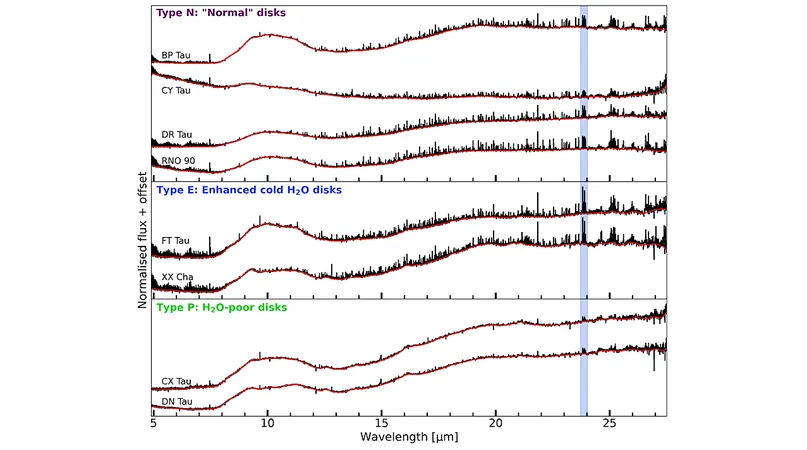
Unlocking the Secrets of Water in Dust Disks: New Findings from JWST
2025-05-30
Author: Wei Ling
A New Era of Astronomy with JWST
The James Webb Space Telescope (JWST) is revolutionizing our understanding of the cosmos, and its latest surveys are illuminating the mysteries surrounding compact dust disks, particularly in relation to water (H2O) distribution.
What Are Compact Dust Disks?
Compact dust disks, which span less than 60 astronomical units (au), are crucial in the formation of celestial bodies. Scientists have long theorized that the icy dust pebbles within these disks may undergo rapid radial drift, potentially creating a rich reservoir of cold water in their inner regions.
Testing the Hypothesis with JWST Observations
In an exciting study, researchers analyzed eight compact disks using JWST's Mid-Infrared Instrument (MIRI). They investigated the distinctive reservoirs of water detectable through pure rotational lines, employing advanced methods like parametric column density profiles and multiple component slab models to uncover what lies beneath the surface.
Diverse Water Reservoirs Uncovered
Surprisingly, not all compact disks exhibited the expected surge in cold water reservoirs. The study distinguishes three classes of H2O distributions in these disks. Four of the disks aligned with ‘Normal’ disks, displaying only a modest cold water reservoir and indicating that the inward drift of dust is less efficient than previously thought.
On the other hand, two disks showcased a significant surge in cold H2O emission, affirming the original hypothesis. Two additional disks were categorized as ‘H2O-poor,’ yet they displayed emissions from both hot and nearby reservoirs.
New Discoveries Beyond Water
Importantly, the team's sophisticated analyses yielded promising results, revealing a variety of water spectra and even hinting at the presence of methane (CH4) in the CY Tau disk.
Conclusion: A Complex Cosmic Puzzle
These groundbreaking findings not only deepen our understanding of H2O distributions in dust disks but also encourage further inquiry into the diverse chemical compositions of these galactic formations. As JWST continues its mission, who knows what other cosmic secrets it will unveil?



 Brasil (PT)
Brasil (PT)
 Canada (EN)
Canada (EN)
 Chile (ES)
Chile (ES)
 Česko (CS)
Česko (CS)
 대한민국 (KO)
대한민국 (KO)
 España (ES)
España (ES)
 France (FR)
France (FR)
 Hong Kong (EN)
Hong Kong (EN)
 Italia (IT)
Italia (IT)
 日本 (JA)
日本 (JA)
 Magyarország (HU)
Magyarország (HU)
 Norge (NO)
Norge (NO)
 Polska (PL)
Polska (PL)
 Schweiz (DE)
Schweiz (DE)
 Singapore (EN)
Singapore (EN)
 Sverige (SV)
Sverige (SV)
 Suomi (FI)
Suomi (FI)
 Türkiye (TR)
Türkiye (TR)
 الإمارات العربية المتحدة (AR)
الإمارات العربية المتحدة (AR)